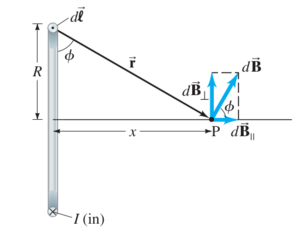Difference between revisions of "Solutions 060519"
(Created page with "__NOTOC__ ==Question 1== The two fragments can be treated as point charges for purposes of calculating their potential energy. Using energy conservation, the potential energy...") |
|||
| (2 intermediate revisions by the same user not shown) | |||
| Line 8: | Line 8: | ||
This is about %25 greater than the observed kinetic energy of 200 MeV | This is about %25 greater than the observed kinetic energy of 200 MeV | ||
| + | |||
| + | ==Question 2== | ||
| + | ===(a)=== | ||
| + | |||
| + | Set <math>x = 0 </math> at the midpoint on the axis between the two loops. Since the loops are a distance <math>R</math> apart, the center of one loop will be at <math>x =-\frac{1}{2} R</math> and the center of the other at <math>x =+\frac{1}{2} R</math> . The currents in the loops flow in opposite directions, so by the right-hand-rule the magnetic fields from the two wires will subtract from each other. | ||
| + | |||
| + | for the single coil: | ||
| + | |||
| + | [[File:Exercise060519Problem2s1.png|300px|center|Field due to a coil]] | ||
| + | |||
| + | <math>dB=\frac{\mu_0 I dl}{4\pi r^2}</math> | ||
| + | |||
| + | <math>B=B_\parallel=\int dB \cos \phi =\int dB \frac{R}{r}=\int dB \frac{R}{(R^2+x^2)^{\frac{1}{2}}}=\frac{\mu_0 I}{4\pi r^2}\frac{R}{(R^2+x^2)^{\frac{1}{2}}}\int dl = \frac{\mu_0 I R^2}{2(R^2+x^2)^{\frac{3}{2}}}</math> | ||
| + | |||
| + | In the anti-helmholtz setup: | ||
| + | |||
| + | <math>B(x)=\frac{\mu_0 NI R^2}{2\left[R^2+\left(\frac{1}{2}R-x\right)^2\right]^{\frac{3}{2}}}-\frac{\mu_0 NI R^2}{2\left[R^2+\left(\frac{1}{2}R+x\right)^2\right]^{\frac{3}{2}}}</math> | ||
| + | |||
| + | <math>B(x)=\frac{\mu_0 NI }{R\left[4+\left(1-2x/R\right)^2\right]^{\frac{3}{2}}}-\frac{\mu_0 NI }{R\left[4+\left(1+2x/R\right)^2\right]^{\frac{3}{2}}}</math> | ||
| + | |||
| + | <math>=\frac{4\mu_0 NI}{R}\left\{\left[4+\left(1-\frac{2x}{R}\right)^2\right]^{-\frac{3}{2}}-\left[4+\left(1+\frac{2x}{R}\right)^2\right]^{-\frac{3}{2}}\right\}</math> | ||
| + | |||
| + | |||
| + | ===(b)=== | ||
| + | For small values of <math>x</math>, <math>x^2\approx 0</math> so <math>\left(1\pm\frac{2x}{R}\right)^2\approx=1\pm\frac{4x}{R}</math> | ||
| + | |||
| + | <math>B(x)=\frac{4\mu_0 NI}{R}\left\{\left[4+\left(1-\frac{4x}{R}\right)\right]^{-\frac{3}{2}}-\left[4+\left(1+\frac{4x}{R}\right)\right]^{-\frac{3}{2}}\right\}=\frac{4\mu_0 NI}{5R\sqrt{5}}\left\{\left[1-\frac{4x}{5R}\right]^{-\frac{3}{2}}-\left[1+\frac{4x}{5R}\right]^{-\frac{3}{2}}\right\}</math> | ||
| + | |||
| + | Again we can use the expansion for small deviations <math>\left(1\pm\frac{4x}{5R}\right)^{-\frac{3}{2}}\approx \left(1\mp\frac{6x}{5R}\right)</math> | ||
| + | |||
| + | <math>B(x)=\frac{4\mu_0 NI}{5R\sqrt{5}}\left[\left(1+\frac{6x}{5R}\right)-\left(1-\frac{6x}{5R}\right)\right]=\frac{48\mu_0 N I x}{25 R^2 \sqrt{5}}</math> | ||
| + | |||
| + | The linear coefficient is : | ||
| + | |||
| + | <math>B(x)=Cx</math> | ||
| + | |||
| + | <math>C=\frac{48\mu_0 N I }{25 R^2 \sqrt{5}}</math> | ||
| + | |||
| + | ===(c)=== | ||
| + | Set C equal to 0.15 T/m and solve for the current. | ||
| + | |||
| + | <math>I=\frac{25 C R^2 \sqrt{5} }{48\mu_0 N}=\frac{25 (0.15 \textrm{ T/m}) (0.04 \textrm{ m})^2 \sqrt{5} }{48(4\pi\times10^{-7} \textrm{ Tm/A})(150)}=1.5 \textrm{ A}</math> | ||
Latest revision as of 06:55, 6 May 2019
Question 1
The two fragments can be treated as point charges for purposes of calculating their potential energy. Using energy conservation, the potential energy is all converted to kinetic energy as the two fragments separate to a large distance.
This is about %25 greater than the observed kinetic energy of 200 MeV
Question 2
(a)
Set at the midpoint on the axis between the two loops. Since the loops are a distance apart, the center of one loop will be at and the center of the other at . The currents in the loops flow in opposite directions, so by the right-hand-rule the magnetic fields from the two wires will subtract from each other.
for the single coil:
In the anti-helmholtz setup:
(b)
For small values of , so
Again we can use the expansion for small deviations
The linear coefficient is :
(c)
Set C equal to 0.15 T/m and solve for the current.









![{\displaystyle B(x)={\frac {\mu _{0}NIR^{2}}{2\left[R^{2}+\left({\frac {1}{2}}R-x\right)^{2}\right]^{\frac {3}{2}}}}-{\frac {\mu _{0}NIR^{2}}{2\left[R^{2}+\left({\frac {1}{2}}R+x\right)^{2}\right]^{\frac {3}{2}}}}}](https://wikimedia.org/api/rest_v1/media/math/render/svg/991a4b70162a6390c0d1ec74dfe74c6ce5e5a953)
![{\displaystyle B(x)={\frac {\mu _{0}NI}{R\left[4+\left(1-2x/R\right)^{2}\right]^{\frac {3}{2}}}}-{\frac {\mu _{0}NI}{R\left[4+\left(1+2x/R\right)^{2}\right]^{\frac {3}{2}}}}}](https://wikimedia.org/api/rest_v1/media/math/render/svg/5bc89e2846143c18d0b14a5bad7f5fddbf0f923e)
![{\displaystyle ={\frac {4\mu _{0}NI}{R}}\left\{\left[4+\left(1-{\frac {2x}{R}}\right)^{2}\right]^{-{\frac {3}{2}}}-\left[4+\left(1+{\frac {2x}{R}}\right)^{2}\right]^{-{\frac {3}{2}}}\right\}}](https://wikimedia.org/api/rest_v1/media/math/render/svg/ddd117056b3923af0fdcb7cbb0b880bd3d328535)



![{\displaystyle B(x)={\frac {4\mu _{0}NI}{R}}\left\{\left[4+\left(1-{\frac {4x}{R}}\right)\right]^{-{\frac {3}{2}}}-\left[4+\left(1+{\frac {4x}{R}}\right)\right]^{-{\frac {3}{2}}}\right\}={\frac {4\mu _{0}NI}{5R{\sqrt {5}}}}\left\{\left[1-{\frac {4x}{5R}}\right]^{-{\frac {3}{2}}}-\left[1+{\frac {4x}{5R}}\right]^{-{\frac {3}{2}}}\right\}}](https://wikimedia.org/api/rest_v1/media/math/render/svg/155af4f6cea6aa811424b0b5365ace1e1ba70855)

![{\displaystyle B(x)={\frac {4\mu _{0}NI}{5R{\sqrt {5}}}}\left[\left(1+{\frac {6x}{5R}}\right)-\left(1-{\frac {6x}{5R}}\right)\right]={\frac {48\mu _{0}NIx}{25R^{2}{\sqrt {5}}}}}](https://wikimedia.org/api/rest_v1/media/math/render/svg/3bbad66a67e262f20660d725e7c2faf022fb761c)


